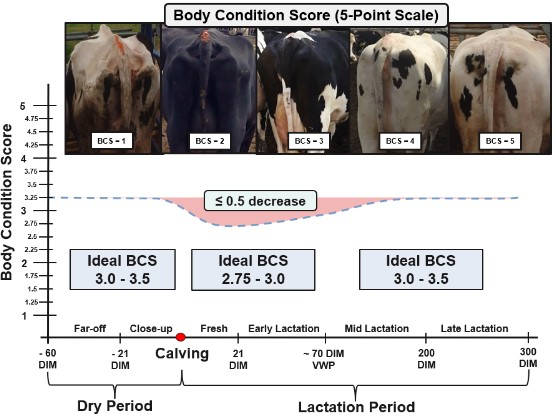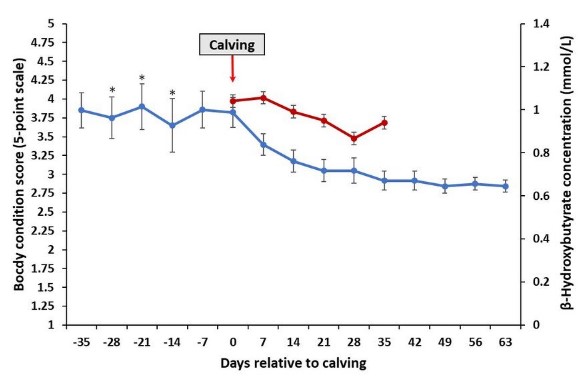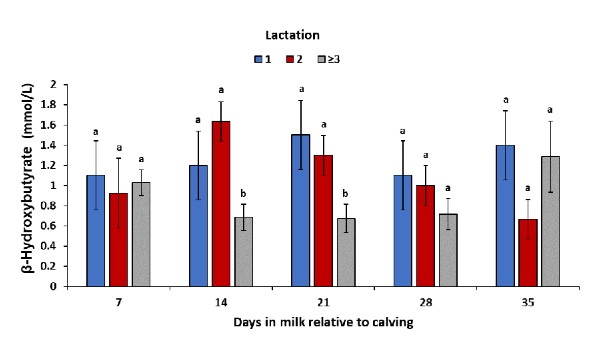By Adrian B Barragan
Excellent nutrition during lactation results in proper body condition in dry cows, which is a determining factor for a successful next lactation.
Excellent nutrition during lactation results in proper body condition in dry cows, which is a determining factor for a successful next lactation. Body condition is regulated by physiological and genetic mechanisms and can be easily influenced by environment (e.g. feeding levels, stocking densities). Good body condition in dry cows can only be achieved with correct management throughout the entire lactation.
The transition period is considered one of the most challenging times for dairy cows and extends from three weeks before parturition to three weeks after parturition (Drackley, 1999). One of the main challenges during this period is a physiological drop in intake coupled with an increase in the energy demands (mainly from the initiation of lactation), which causes a negative energy balance (Drackley, 1999). This predisposes dairy cows to mobilize fat tissue to make up for the lack of energy, which in turn decreases the body condition of these animals.
When cows are not properly managed (e.g., overstocking, inadequate nutrition, high incidence of diseases), the drop in dry matter intake is magnified and cows intensively mobilize fat tissue, subsequently developing ketosis, which is an important risk factor for metabolic and infectious diseases, as well as poor production and fertility (Benedet et al., 2019). Furthermore, due to intensive genetic selection toward higher milk yields in the last decades, the mobilization of adipose tissue has been greatly intensified (Cousillas et al. 2019).
Body condition score (BCS)
A system to subjectively measure cows’ body reserves was first designed in the 70s (Lowman eta al., 1973). Since then, multiple systems aiming to score the degree of apparent fat tissue accumulation were developed around the world. In the United States, a 5-point body condition score system that progresses in quarter points (0.25 points) has been widely adopted (Ferguson et al., 1994). You can learn more about the description and use of this scoring system through practical educational materials developed by Penn State Extension (Link: body condition in dairy cows).
Numerous studies suggest an optimum calving BCS between 3.0 and 3.5. A lower BCS than this may be associated with lower production and reproductive performance, while a higher BCS (>3.5) may reduce feed intake and increase risk for metabolic diseases (Lüttgenau et al., 2016). Furthermore, during the transition period animals should lose no more than 0.5 BCS points (Roche et al., 2009). A practical summary of the recommended BCS across the production cycle is provided in Figure 1.
Body condition and its relationship with health and performance
There is a general perception that thin cows may have more health issues; however, there is not much research supporting this hypothesis. Conversely, there are many studies suggesting that there is an association between over-conditioned cows and impaired immune response (Roche et al., 2009). This may be caused by the greater BCS loss post calving that is associated with over conditioned cows (Contreras and Sordillo, 2011).
It has been reported that fresh cows with BCS >3.5 have 30% greater odds of succumbing to milk fever than cows with BCS of 3.0 (Roche and Berry, 2006). This might be due to the decreased post-caving dry matter intake observed in cows with greater BCS (>3.5) and the higher demand of calcium for milk production (Roche et al., 2009). Additionally, cows with a BCS of >3.5 at calving are at a higher risk of developing ketosis compared to those with a BCS of 3.25 (Gillund et al., 2001).

Figure 1. Body condition score recommendations for lactating and dry dairy cows.
There are only limited studies that have evaluated the relationship between body condition and infectious diseases such as mastitis or metritis. For instance, in a study involving almost 10,000 dairy cows, cows that lost body condition during the dry period had a greater incidence of uterine diseases and indigestion (Chebel et al., 2018). Similarly, losing body condition during the dry period was associated with a higher likelihood of antimicrobial and anti-inflammatory treatments (Chebel et al., 2018). Furthermore, there is evidence that indicates that rapid loss of condition during the transition period may reduce the chances of recovery from infectious diseases (Contreras and Sordillo, 2011).
In addition to the negative effects that body condition loss has on animal health, losing body condition before or after calving affects the fertility of dairy cows. For instance, cows that lost body condition during the dry period had a lower pregnancy rate after first and second postpartum inseminations (Chebel et al., 2018); while a lower proportion of cows that lost body condition during the first 60 days after calving became pregnant compared to cows that maintained or gained body condition (Carvalho et al., 2014).
Body condition profile
Generally, the body condition profile of a cow starts high and slowly declines to a lowest point at 40 to 100 days in milk (DIM). On the other hand, milk production starts low and peaks almost at the same time that body condition reaches its lowest point. However, soon after milk peaks are reached, cows slowly drop production and start replenishing body reserves. This is a physiological hormone-regulated process that cows experience as their bodies prepare for the next lactation.
Management has an effect on fat accumulation, whereas condition lost is generally regulated by genetics (Roche et al., 2009). It has been calculated that up to 60% of variations in BCS are due to differences in genetic makeup (Roche et al., 2009). This might explain why there are cows that start accumulating body reserves faster than others, which in many cases may end up as over conditioned and lower production cows that need to be dried off earlier.
In dry cows, the increase of body condition can get accentuated when an inappropriate diet is provided. It is a common practice to provide leftovers from the lactating cow ration to the dry cows or use the lactation ration as part of the dry cow ration. These lactating cow rations are designed to have high energy that this particular group of cows may not need. Unfortunately, these practices can accelerate the fat accumulation process during the dry period. It is recommended that cows do not lose or gain body condition during the dry period; otherwise, cows would be more likely to develop ketosis. Additionally, small herds that have only a few dry cows, tend to mix rations for more than one day. This practice may cause a low feed intake which can result in body condition losses in the cows.
Study Case
A field study case was conducted on a 60-cow dairy farm in Lancaster County, PA, last winter (2018) to evaluate body condition changes and its impacts on metabolic status in transition cows. Eleven dairy cows of different parities were enrolled at 35±3 days prior to calving and followed for 63±3 days after calving. Body condition scores were recorded weekly by the same person during the study period. Blood samples for assessment of ketones body concentration were collected at 0±3, 7±3, 14±3, 21±3, 28±3 and 35±3 days after calving. Concentration of ketone bodies (ß-hydroxybutyrate; BHB concentrations) were measured using a handheld device (BHBCheck™, PortaCheck & PortaScience, Moorestown, NJ).

Figure 2. Body condition score (solid blue line; average ± standard deviation) and ketone bodies concentrations (ß-hydroxybutyrate; solid red line; average ± standard deviation) of peri-parturient dairy cows. * indicates statistical differences.
Results indicate that the average body condition of this group of cows at calving (± 3 days) was 3.82 (Figure 2). This condition rapidly dropped to 3.39 on day 7 ±3 after calving and to 3.18 at day 14±3 after calving (Figure 2). Body condition reached the lowest point at day 21±3 after calving with an average body condition of 3.05 (Figure 2). There were statistically significant differences in BCS between the pre-calving days -28, -21 and -14 and post-calving days (Figure 2).
Even though a drop in BCS is expected after calving, the study animals lost condition in a very rapid and high manner. The total BCS loss was 0.77 points after 3 weeks post-calving. As mentioned before, this rapid and large fat mobilization upsurges the risk of infectious and metabolic diseases and decreases cow performance and fertility, increasing the likelihood of early culling of those animals.
It is recommended that cows maintain body condition during the dry period; however, dry cows are often over conditioned or even worse, underconditioned. Adjusting body condition during the transition period is not recommended, and nutritional recommendations to achieve good body condition in different groups must be followed. It is crucial that producers identify, through regular monitoring of BCS, cows that are accumulating fat early during the lactation period and mange those animals nutritionally different to avoid over conditioning.

Figure 3. Circulating concentration of ketone bodies (ß-hydroxybutyrate; average ± standard deviation) in blood of post-partum dairy cows grouped by parity. Different letters within the same group of columns represent significant differences.
The average blood BHB concentration at calving was 1.04 mmol/L and, although there were numerical differences between post-partum days, these differences were not statistically significant (Figure 2). Regardless of post-partum days, second and first lactation cows had the highest BHB concentrations between 14±3 and 21±3 days after calving (Figure 3). This pattern in BHB concentration often reflects management issues, such as overstocking, that does not allow younger cows to compete with older animals in order to cope with the challenges of the transition period. In this group of cows, there were two subclinical ketosis cases (i.e., BHB > 1.2 mmol/L) and one cow died due to hypocalcemia complications.
Feeding nutritionally poor diets, overstocking, and commingling first lactation cows with older cows are management practices that can increase fat mobilization during the transition period. These issues are easy to identify and address in conventional farms if proper monitoring of BCS is performed on a weekly basis; however, addressing some of these issues may be costly (e.g., adding a new barn). Alternative solutions such as grouping cows for fewer days in milk and dividing pens with gates or fencing may be possible options in these situations.
This particular farm fed lactating cow ration to the dry cows, which could be one of the reasons that dry cows had a greater body condition score than recommended. Also, it was reported that the farm had issues with reproductive performance, which may be another important factor that could cause the observed over conditioning in dry cows. This is a vicious cycle since poor reproductive performance predisposes cows to have a long lactation with low milk production, leading to over conditioning; while over conditioned cows are at a higher risk of developing metabolic diseases during the transition period which impairs reproduction. A critical first step toward addressing this issue is to actively and accurately monitor and treat metabolic and infectious diseases in cows during the post-partum period and assess and polish the reproductive program to maximize reproductive performance. Implementation of other best management practices, such as preventing heat stress and avoiding overstocking of transition cows, may be beneficial for addressing this issue.
Source: psu.edu